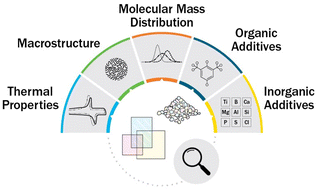Characterization of polymer properties and identification of additives in commercially available research plastics†
Abstract
For polymer recycling research, consistent polymer substrates sourced from widely available vendors are useful to enable direct comparisons between studies. Additionally, when reporting new recycling approaches, it is essential to characterize polymer chemical composition, physical properties, structure, and the presence of additives. Here we characterized 59 polymers from common commercial vendors across 20 different polymer classes, representing >95% of global plastic production by mass. Structural characterization was conducted with gel permeation chromatography, Fourier-transform infrared spectroscopy, and small and wide-angle X-ray scattering, and bulk characterization included CHNS measurements and elemental analysis by inductively coupled plasma mass spectrometry (ICP-MS). Thermal properties were measured using differential scanning calorimetry (DSC) and thermal gravimetric analysis. Nearly all plastics studied contained inorganic and organic additives, including halogens, sulfur-containing compounds, and antioxidants, which were investigated by either ICP-MS, accelerated solvent extraction followed by gas chromatography-mass spectrometry (GC-MS), pyrolysis GC-MS and high-resolution GC-MS. In general, the polymers vary from what they were reported to be, with 5 polymers exhibiting molar mass distributions different from that provided by vendors, 6 polymers exhibiting bimodal molecular mass distributions, and 10 polymers displaying unexpected thermal properties measured by DSC including multiple glass transitions and unusual exotherms. Finally, we also investigated changes in properties pre- and post-cryomilling, a common preprocessing technique in recycling studies. Here we found that 16 polymers had changes in either the average molecular mass, dispersity, or percent crystallinity after cryomilling. Taken together, this study further highlights the need to conduct thorough characterization on polymer substates while also providing a baseline analytical characterization for widely available research plastics. We have further made all data available through an online database.

- This article is part of the themed collections: 2024 Green Chemistry Hot Articles and Green Chemistry 25th Anniversary Collection


 Please wait while we load your content...
Please wait while we load your content...